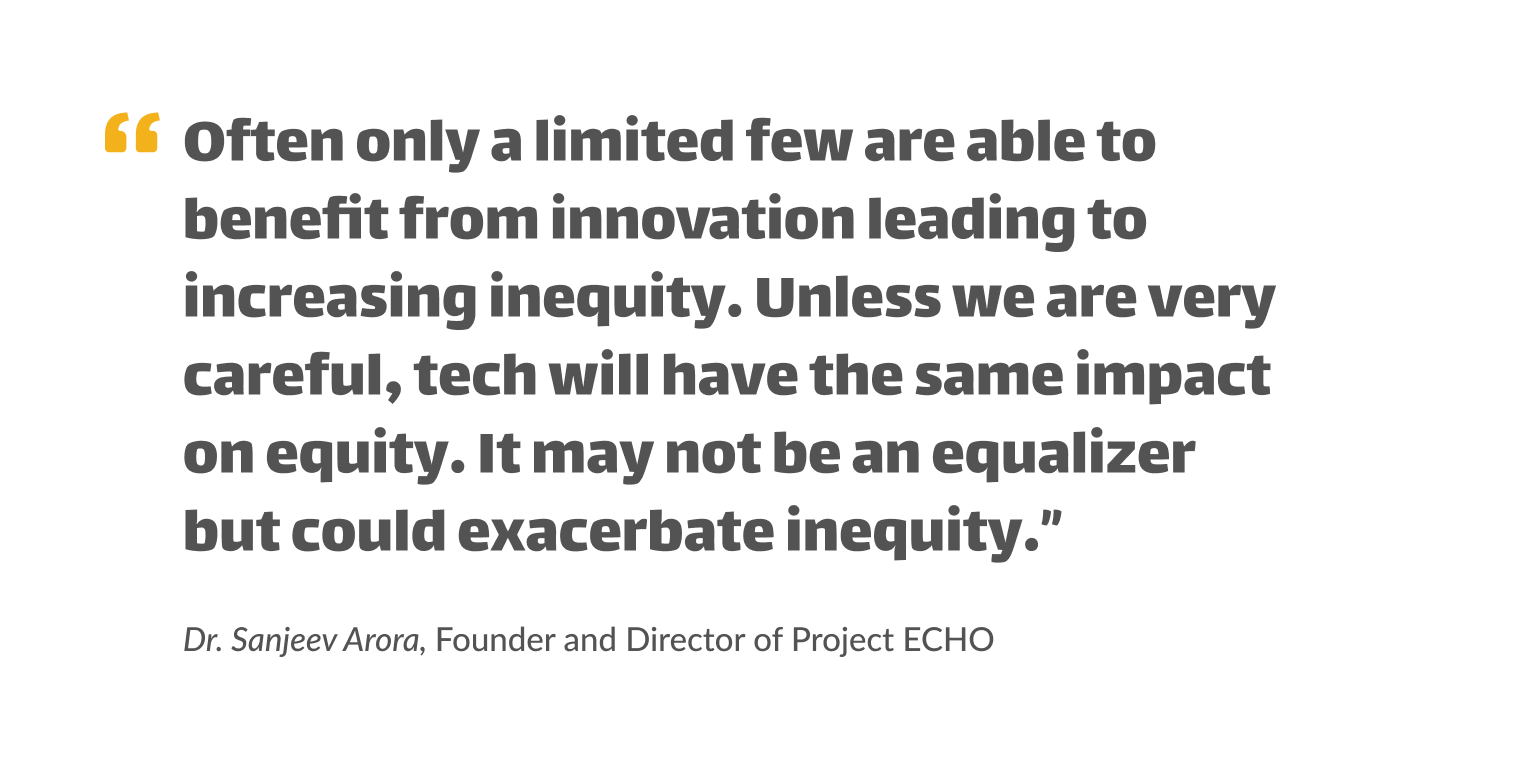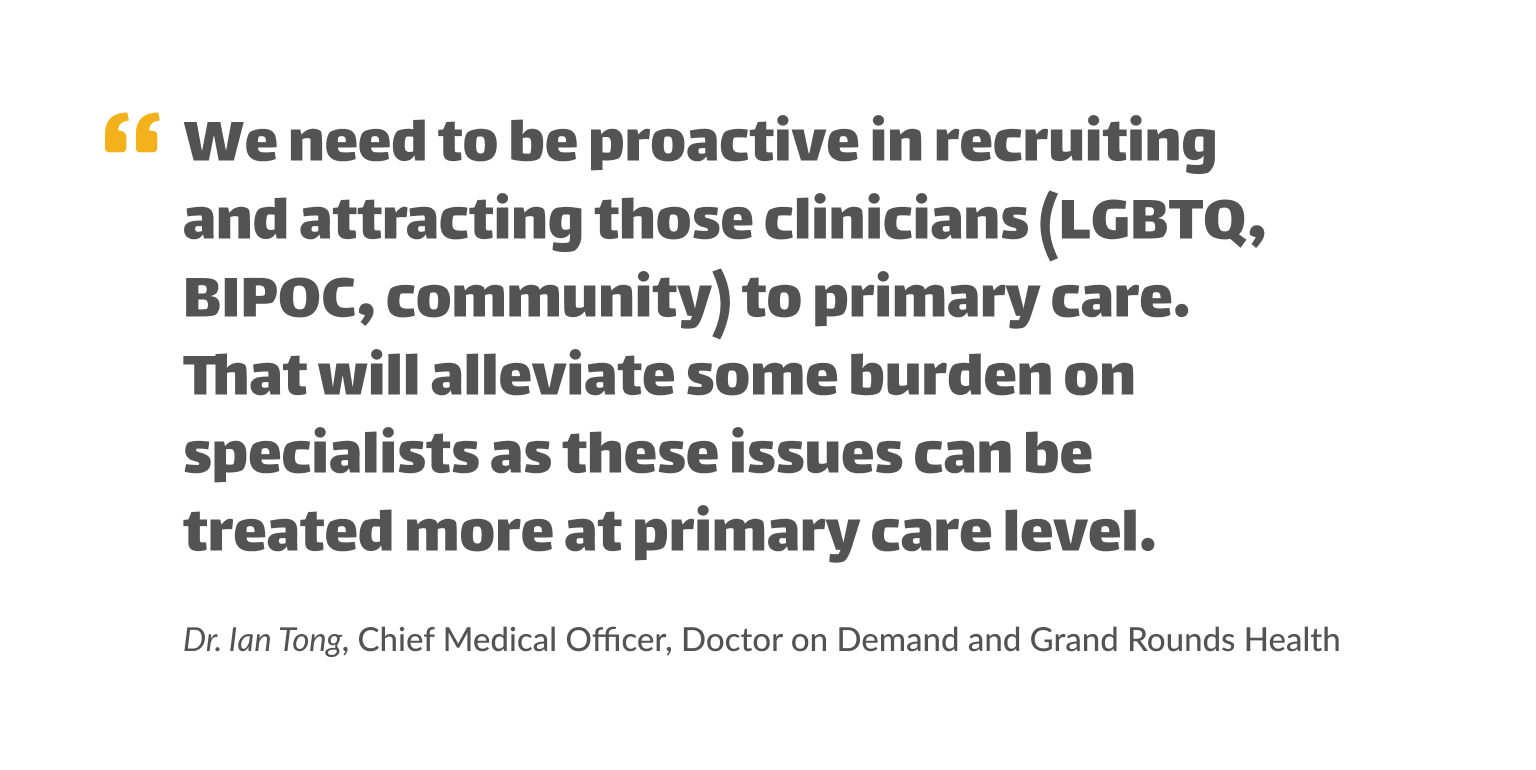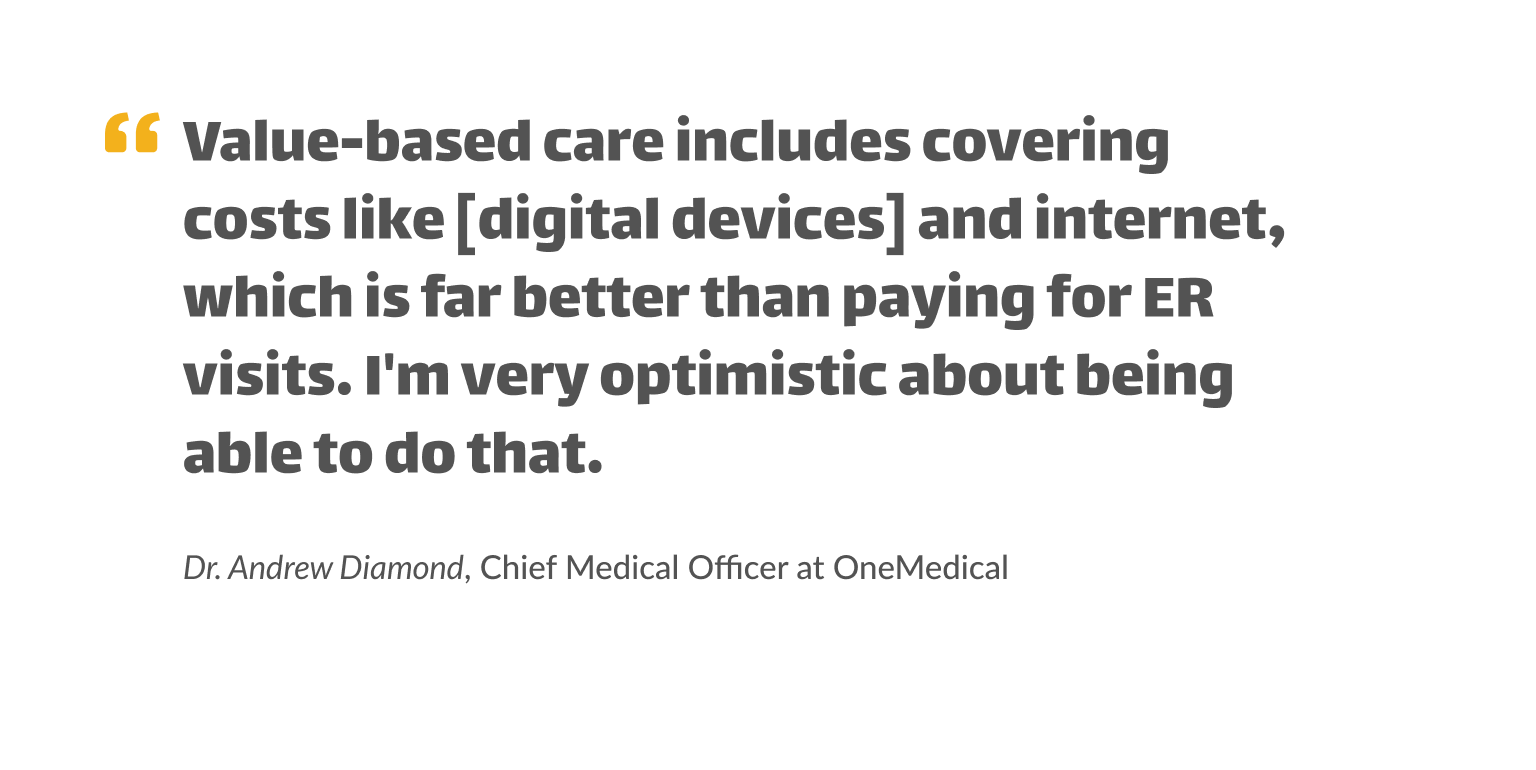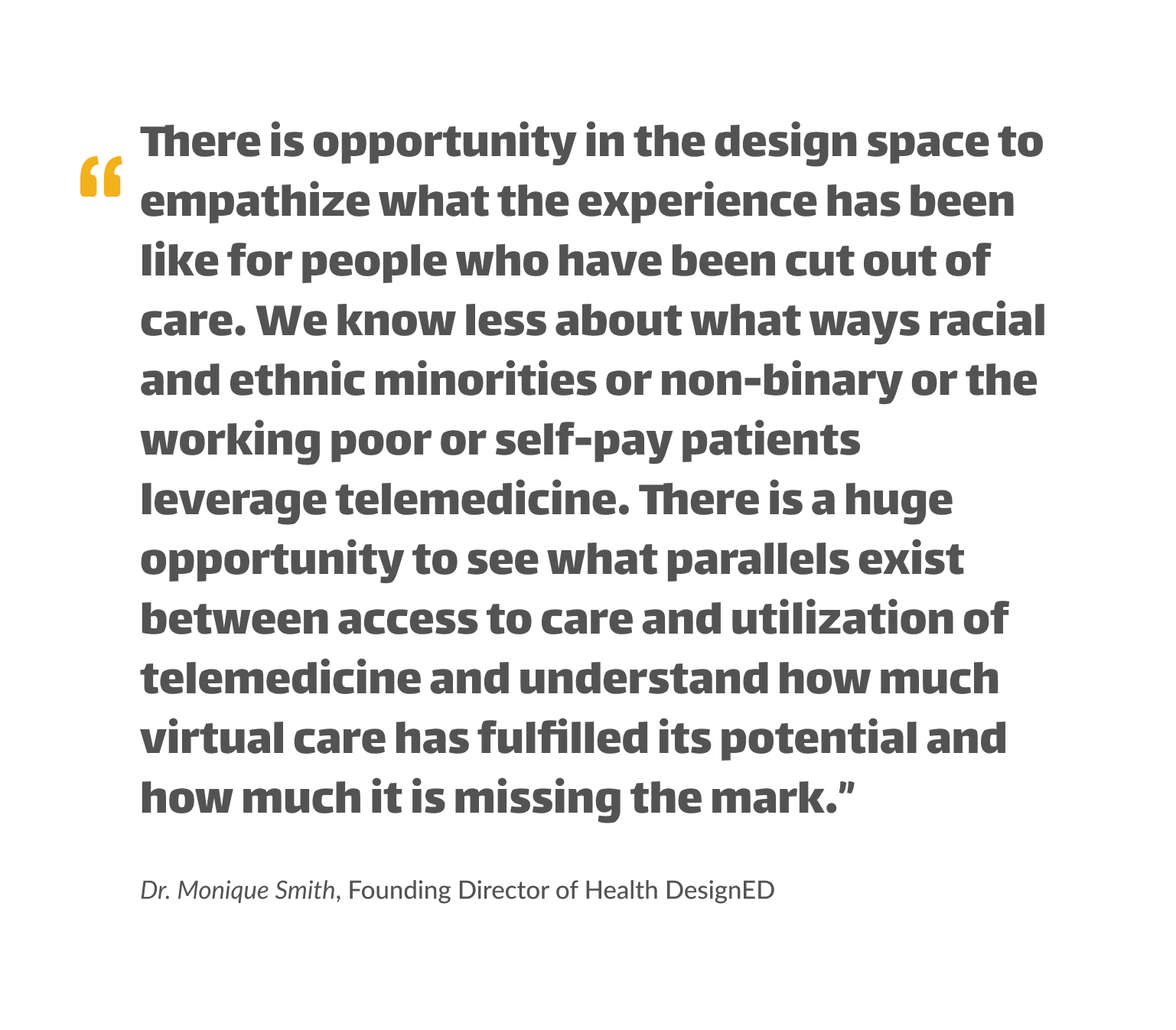Dalberg uses cookies and related technologies to improve the way the site functions. A cookie is a text file that is stored on your device. We use these text files for functionality such as to analyze our traffic or to personalize content. You can easily control how we use cookies on your device by adjusting the settings below, and you may also change those settings at any time by visiting our privacy policy page.
Dalberg recently hosted a webinar with four medical practitioners who are helping to redefine the intersection of health tech and equity. This is what we learned.
While the health technology market has been growing consistently for more than a decade, the Covid-19 pandemic made virtual visits and remote monitoring critical to patients and providers alike. One in three U.S. adults used telehealth in the first six months of the pandemic and more than 80% of patients plan to use telehealth in the future.
Valuations and funding are keeping pace with changes in consumer behavior: In 2021, the U.S. health technology market topped $110B, fueled by multiple companies (25 in Q1) closing deals over $100M and equity funding to digital health companies reaching an all-time high of almost $10B in Q1 of 2021.
While better digital access to healthcare offers the promise of more accessibility and inclusivity and fewer barriers to care, in practice, this is not always the case. Telehealth has the potential to reinforce and amplify the disparities that already exist throughout the U.S. healthcare system. The senior population, BIPOC patients, and rural Americans are at particular risk of being left out.
The available telehealth data demonstrates these inequities. Just 24% of adults over 65 used telehealth in 2020, compared to 40% of younger Americans. Black patients are more likely than white patients to use the emergency room instead of a telehealth visit (JAMA). And, 10% of Americans lack access to adequate internet for virtual consultations, a challenge that is disproportionately present in rural areas.
For the first session in a new series on accelerating progress toward a more equitable future in the United States, Dalberg brought together four physicians working at the forefront of health technology to hear about their first-hand experience of virtual care provision during the pandemic, debate the positive and negative impacts of health technology on equity, and discuss opportunities for positive growth and change.
Our panelists included: Dr. Sanjeev Arora, Founder and Director, Project ECHO; Dr. Andrew Diamond, Chief Medical Officer, One Medical; Dr. Monique Smith, Founding Director, Health DesignED; Dr. Ian Tong, Chief Medical Officer, Doctor on Demand and Grand Rounds Health; with Lily Chhatwal, Associate Partner at Dalberg and co-lead of Dalberg’s Americas Health practice serving as moderator.
Digitized health services that start with equity: Four ways to include the underserved
Four key insights emerged on how we can deliver a more equitable future in health technology:
- Design for equity from the start, recognizing the specific needs of different patient groups
Telehealth holds the potential to bring health services to new populations, simplify interactions for service providers, and improve understanding of patient populations — but these ambitions will be difficult to meet if equitable principles are not baked into the service designs from the start. Without careful design, technology could also exacerbate inequality.Designing for equity in virtual care means maximizing the demographic overlap between providers and patients, even if that means going across state lines. For example, Dr. Ian Tong shared how Black LGBTQ patients could find a Black LGBTQ-identifying physician using virtual care systems, even if they don’t live nearby.Services like Doctor on Demand and Grand Rounds Health currently prioritize provider-patient connections based on demographic data and have established ways to prioritize underserved populations. More than 50% of clinicians at Doctor on Demand identify as LGBTQ and/or BIPOC.
Seniors’ needs must also be considered. For example, the CMO of OneMedical, Dr. Andrew Diamond, treats patients with an average age in their seventies. He has found ways to make patients more comfortable with technology use, such as providing device access and training prior to appointments.

- Democratize specialist knowledge and extend the capacity of primary care
In addition to barriers related to equity, the United States has a physician shortage that adds to the challenges of accessing care. Many areas do not have enough physicians, and waitlists for specialists can last months. Unfortunately, the shortage is only expected to grow.In addition, the Covid-19 pandemic will likely lead to both short- and long-term impacts for the country’s medical workforce, including increased potential for physician burnout and interruption of medical education for some doctors in training. A 2020 study predicted a shortage of up to 139,000 physicians by 2033 (AAMC).Already underserved patients will most keenly feel the effects of the shortages. As one example, Dr. Sanjeev Arora, Founder and Director of Project ECHO, is based in New Mexico, where 32 of the state’s 33 counties are defined as ‘medically underserved.’ Across New Mexico, 45,000 chronic Hepatitis C (HCV) patients face a dearth of specialists to treat their condition. As a result, the state experiences the highest rate of liver cancer in the country.
Yet, these rates are beginning to decline, as the state and organizations like Project ECHO (Extension for Community Healthcare Outcomes) work to increase HCV screening and share specialty HCV treatment knowledge with physicians in rural areas. Project ECHO trained providers through its one-day provider training and involved community clinicians in its ongoing HCV TeleECHO Clinic. Through these programs, Project ECHO has increased the capacity of the healthcare system to manage HCV before it becomes critical for both patient outcomes and hospitals.

- Payment reform is key: Technology will not fix issues of equity and trust if we do not overhaul the way our healthcare system intersects with patients’ financial lives
Reforming the health payment system underpins every conversation related to telehealth and technology’s potential to facilitate care. A payment system that focuses on quality of care, rather than quantity, is an important step in the right direction.Today’s payment system is dominated by a fee-for-service payment model that charges patients and insurance companies based on each intervention performed during a visit. Rather than incentivizing better treatment and outcomes, it sets the stage for overuse of services, often leading to unnecessary procedures and inefficient care delivery.Value-based care, an alternative payment system that is slowly gaining traction in clinics across the country, bases payment on health outcomes rather than interventions. Value-based care is especially effective in meeting the needs of high utilizers, such as patients that frequently visit the emergency department.
For example, if patients can be provided with a tablet and on-demand virtual care visits with a provider, it may be easier to manage their care on an ongoing basis, rather than having their concerns or conditions ladder up into a series of very expensive visits to the emergency room. Ultimately, value-based care improves financial alignment with the best interventions for the condition and patient at hand, regardless of whether those interventions are medical services or other forms of care.
Many vertically integrated payment and provider systems are recognizing value-based care as an effective alternative for traditional payment systems, while in other places, health facilities are teaming up with Medicare or Medicaid to make value-based care an option for high-risk patients.

- Continue to learn from the Covid-19 pandemic to build momentum for health technology
Virtual systems for patient triage were implemented due to Covid-19. These systems separated patients with virus symptoms from those who required other medical assistance.Across the pandemic, Dr. Monique Smith, the Founding Director of Health DesignED at Emory University in Atlanta, worked with one such triage tool: a symptom checker that enabled patients to determine if they needed to go to the hospital immediately, call a nurse line, or see a doctor virtually.Emory’s health clinic, along with many other clinics nationally, made sure these triage resources reached underserved populations through texting and social media campaigns. Continuing the use of patient triage has significant potential to enhance the efficiency of virtual care visits and enable a more effective balance between in-person and virtual visits.
Federal and local deregulation of health technology is another positive development in achieving better healthcare equity through telehealth services. New government policies enable providers to bill for virtual visits and improve data sharing.
For example, after a January 2021 Center for Medicare and Medicaid Services (CMS) recommendation to states to ease payment restrictions for virtual visits, many Medicare and Medicaid recipients were eligible to bill at-home virtual visits, and healthcare companies used real-time eligibility criteria to look up to ease access to these services. Companies like Doctor on Demand were able to show the co-pay amount in advance, improving price transparency and lowering the barrier to care.
These changes, while made in an emergent environment, have augmented access to virtual care for underserved populations. Moving forward, this progress can be built upon by better utilizing and sorting data—a practice that would give providers better insight into equity and patient outcomes.

Conclusion
Health technology will change the way we interact with health. Increased virtual visits, digital care triage, and patient monitoring promise to reduce barriers to accessing care, especially for those with limited mobility or who live in hard-to-reach settings. Virtual care providers can connect patients to doctors with similar backgrounds and keep patients out of the emergency room by providing timely responses to patient concerns.
Without careful design, this innovation has the potential to leave people behind, as we have seen throughout the pandemic. Health technology is just one component of an integrated system of care that should prioritize equity and access. This begins with the democratization of provider knowledge, payment reform, and a focus on what is most needed by underserved patients. As Dr. Andrew Diamond, Chief Medical Officer of OneMedical, concluded in the panel, “We need to be good stewards of technology as it develops.”
Sign up to receive information on future sessions in the ‘Accelerating an Equitable Future in the US’ series or ongoing Dalberg initiatives here.

